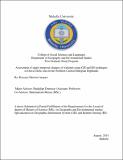| dc.description.abstract | Wetland resources play an important role in sustaining human, plant and animal life. They
balance climatic and hydrology cycle to our environment. However, wetlands have been
decreased both in time and space. This in turn narrowed the opportunities of wetland services.
Thus, the study focused on assessment of the spatio-temporal change of wetlands and its socioeconomic
effect in Northern Central Ethiopian highlands. Four sets of Landsat satellite
imageries for the years of 1984, 1993, 2000 and 2013 were used to produce land cover maps and
quantify the land use and land cover dynamics. Moreover; practical observation, structured
questionnaire and focus group discussions were used to supplement remotely sensed satellite
data. The qualitative data were then narrated. Unlike built up area expansion, grassland and
farmland, the land use and land cover analysis showed that wetlands are reduced from the year
1984 to 2013. Overgrazing, water diversion for irrigated farm, waste dumping, and rapid
population growth are the key driving forces of wetlands changes. Moreover, the study shows
that wetland change brought social effect in the study area. In this regard, the shrinkage of the
wetlands caused prevailing conflict between nomads and local farmers as both of them need
wetland for different purposes. As they are more dependent on the wetland resources, the
nomads were more resistant to the strategies of the government. The study also showed that
wetland loss has controversial effects. In this respect when wetland loss increases swampy plants
and animals also decreased and even later disappeared. Economically very important mangrove
species started declining which directly affected the lives of nomads. Conversely, when wetland
decreases, farmers encroach the wetlands for agricultural and grazing land due to the fact that it
is very fertile and suitable for the application of modern irrigation. This is, however, at the
expense of wetland loss. In conclusion, the study highlights that the wetland size has been
decreased and brought ecological and socio-economic effect in the study area. Therefore, the
government and other stakeholders should intervene by providing appropriate water
management practices, awareness creation and family planning education to enhance
sustainable land management and to meet the national and international interest linked to the
Millennium Development Goals. | en_GB |


